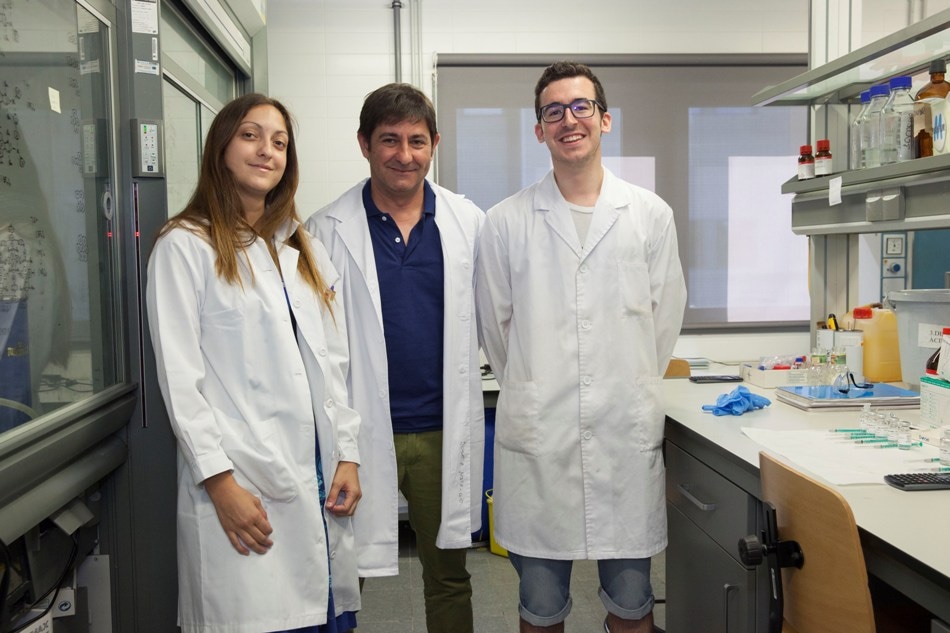Sep 19 2017
A team of Scientists from the Universitat Jaume I de Castelló, the Institute of Chemical Technology of the Universitat Politècnica de València-CSIC and the University of Zaragoza, coordinated by Professor José Antonio Mata of the UJI, have created and patented an innovative process for efficient production, storage and safe transportation of hydrogen for use in fuel cells via the use of chemical reagents. The new technology is based on the use of liquid hydrogen organic carriers (LOHC).
 The researchers Pilar Borja, José Mata and Andrés Mollar in one of the laboratories of the UJI. Credit: UJI
The researchers Pilar Borja, José Mata and Andrés Mollar in one of the laboratories of the UJI. Credit: UJI
Hydrogen is considered as an excellent fuel due to its high energy density and zero greenhouse gas emissions. When combined with atmospheric oxygen, hydrogen produces water and energy as the only by-product and makes it one of the key candidates to replace fossil fuels as an energy source for the transport sector.
In spite of this, still there are some limitations that have prevented the execution of the so-called "hydrogen economy". The first limitation is that this gas is not found in the crust of the earth and therefore, it has to be produced in a process that is not generally sustainable, and the second one is its flammable nature and the necessity to transport it in a compressed manner, with the dangers they derive.
The key benefit of these liquids is that they can easily store hydrogen for long periods of time and can be transported through the current infrastructure. The Researchers have explored different hydrogen-bearing organic liquids in order to attain a novel hydrogen storage system based on a chemical coupling reaction between an alcohol and a hydrosilane catalyzed by a ruthenium compound supported in graphene.
With respect to the already established systems, the contributions of the new process are multiple. Firstly, it is a chemically versatile process because various combinations of alcohols and hydrosilanes can be used. Secondly, the process can be carried out very fast and elevated temperatures are not required because the Researchers have also developed ruthenium catalysts that are extremely efficient for this reaction. Thirdly, the process is reversible as the product formed in the coupling between an alcohol and a hydrosilane is a silyl ether that can be transformed further into the original product by a reductant.
Among its key benefits, it forms an energy system whose only by-product is water and, at the same time, it is reversible, by enabling users to store and produce hydrogen according to requirement. It can be easily customized to non-static energy generation and employ systems, such as automobiles; the use of silane-alcohol as LOHC allows operation at low temperatures in achieving the gas and the technology avoids the safety problems of hydrogen storage.
There are four large blocks involved in the overall energy generation process. The first one is production and its challenge would be to achieve hydrogen from alternative energies such as wind or solar, in a quasi-sustainable method; as that would be desirable that the by-products derived were obtained in an industrial center where the generation was fully controlled. In the second (transportation) and third (distribution) blocks, which do not require any innovation in the scientific or industrial field, the proposed system could employ the existing infrastructure for both transportation and distribution of petroleum products. The fourth block contemplates the chemical reaction for achieving hydrogen and its use in fuel cells. The initial results showed that the reaction is very fast and can occur even at room temperature, which corresponds to sufficient kinetics for the production and immediate use of hydrogen.
This new process is aimed at the energy production industry, particularly at the one that uses renewable sources of energy free of greenhouse emissions and pollutants. In particular, it is appropriate for companies that are dedicated to the generation and commercialization of solutions for the transportation and storage of hydrogen as energy vector by using LOHC as hydrogen carriers.
The research group, which has validated the new experimental process in the laboratory environment, includes José Mata (UJI), Project manager, Miguel Baya (UZA) and Hermenegildo García (UPV-CSIC). David Ventura-Espinosa, fellow of the Ministry of Economy and Competitiveness (FPU); Mapi Borja, UJI Postdoctoral Staff; Andrés Mollar, a Graduate Student in Chemistry; and Alba Carretero, Student of the Master's Degree in Applied and Pharmacological Chemistry, are also included in the research group of the UJI.